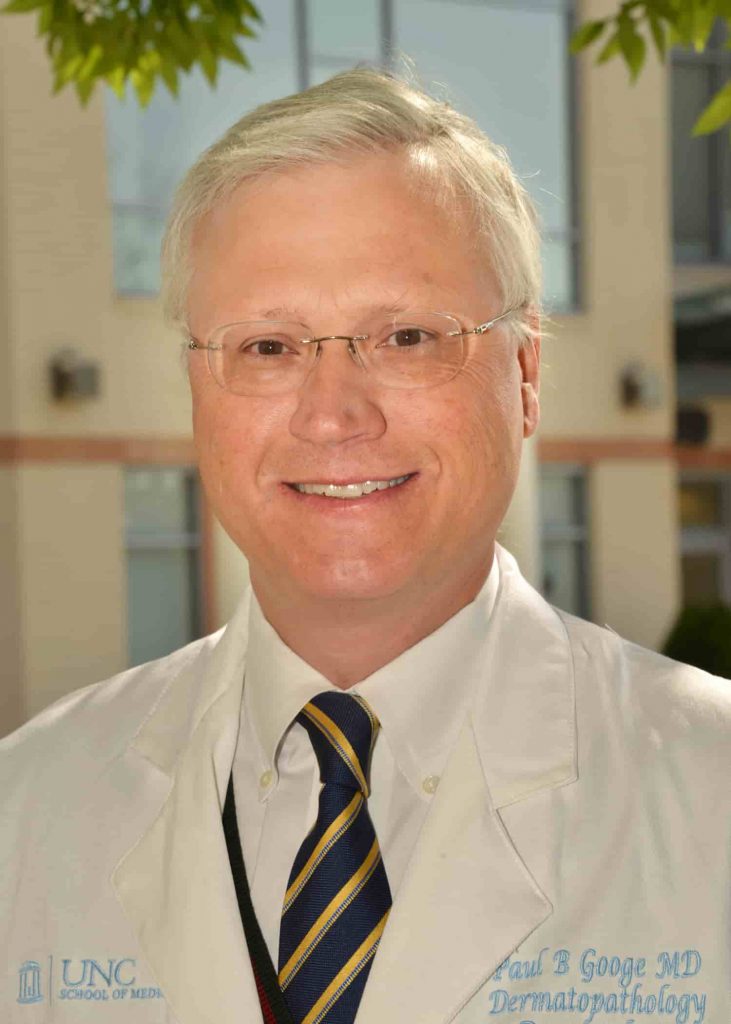Cutaneous angiosarcoma is a rare, highly aggressive skin tumor found primarily on the scalps of older White people, but based on new research from the University of North Carolina School of Medicine and the Lineberger Comprehensive Cancer Center, immunotherapies effective against lung cancer and melanoma may also work against this cancer. The study’s findings are published in the American Journal of Dermatopathology.

The investigators found that two markers that could help guide the choice of immunotherapy to fight this disease: tumor-infiltrating lymphocytes (TILs), which are white blood cells that can kill cancer cells, and surface protein markers, known as PD-1 and PD-L1. Combined, these markers are enabling researcher’s efforts in clinical trials for cutaneous angiosarcomas.
“Current treatments for cutaneous angiosarcomas incorporate surgery, radiation and chemotherapy, but are not overly effective,” said Paul Googe, MD, a professor in the UNC School of Medicine Dermatology Department and lead author. “Most skin cancers regress in response to inflammation and since immunotherapies that provoke an inflammatory response have proven successful in melanoma, immunotherapies targeted at non-melanoma skin cancers, such as angiosarcomas, also now show promise.”

This research was possible due to the efforts of teams of UNC scientists from different fields working together. “It is a big advantage for pushing forward research to have inter-departmental collaboration as seen with this study,” said UNC Lineberger’s Nancy E. Thomas, MD, PhD, chair of the Dermatology Department at the UNC School of Medicine. “This project required true team science, with investigators bringing complementary and integrated expertise to the project.”
“Cutaneous angiosarcomas can be advanced at diagnosis, so treatment is usually multidisciplinary, involving dermatologists, surgical oncologists, radiation therapists and oncologists,” said Googe. “Dermatology experts have been invaluable in helping identify patients for a clinical trial and dermatologic follow-up should be helpful in assessing response to therapy.”
About the study
In this study, the researchers sampled tumor tissue from five men and five women between the ages of 59 and 82 who were newly diagnosed with cutaneous angiosarcoma. They looked at patient tissue samples for the presence of TILs as well as surface proteins PD-1 or PD-L1, which can act as immune checkpoints. Immunotherapy drugs can block PD-1, thereby releasing the brakes on the immune system so that it can attack cancer cells.
In their investigation, all 10 of the patient tumor samples were positive for PD-L1; seven of the tumors expressed PD-L1 at high levels. TILs were all found in all 10 tumors, and more specifically were found at the edge of the tumor and widely comingled with tumor cells in seven of the tumors, indicating a higher likelihood of immune-effectiveness against the cancer.
There have been some individual case reports of success using immunotherapy agents such as pembrolizumab, a PD-1 inhibitor, against cutaneous angiosarcomas. In this study, four of the people showed benefit from pembrolizumab.

“This study is a wonderful example of the bedside to bench, back to bedside,” said UNC Lineberger’s Juneko Grilley-Olson, MD, an associate professor of medicine at the UNC School of Medicine’s Division of Oncology and final author on the article. “Trials in a rare disease require broad-reaching cooperative efforts, and through an extensive network of trial sites supported by the National Cancer Institute, we are bringing our next trial to where patients are, and ask the question of drug effectiveness in the most rigorous scientific way.”
The phase II trial, run through the NCI-sponsored Alliance for Clinical Trials in Oncology network, is looking to enroll as many as 90 patients with angiosarcoma to fully evaluate genetic and other abnormalities in the disease. For the first time in this cancer, investigators will try to determine how responsive the disease might be to immunotherapy in combination with conventional chemotherapy, noted Grilley-Olson.
Authors and Disclosures
In addition to Googe and Grilley-Olson, the paper’s other authors include Kyle Flores, MD, Francie Jenkins, MD, and Bradley Merritt, MD, UNC School of Medicine, and Stergios J. Moschos, MD, UNC Lineberger and UNC School of Medicine.
The authors declare no conflicts of interest.
